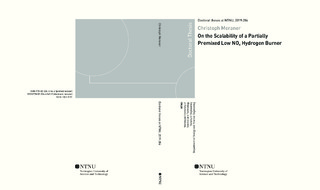| dc.description.abstract | Increasingly stringent regulations on nitric oxide (NOx) emissions led to the development of various low and ultra low NOx combustion technologies over the last decades. These technologies are further challenged by the increasing demand for fuel flexibility and rising contribution of non-carbon fuels to the global fuel mix, such as for example hydrogen. Modern burners incorporate complex designs and flow regimes, to address the high burning velocities and temperatures associated with hydrogen and hydrogen rich fuels, allowing stable combustion and low NOx emissions. The development process of such burners requires the scaling of the burner geometry to facilitate simulations and testing at laboratory scale. Scaling is conducted by employing scaling laws, that aim to preserve relevant burner characteristics.
The present doctoral thesis investigates the effect of the most commonly used scaling laws, constant velocity and constant residence time scaling, on complex burner designs. Both scaling laws are derived based on "simple" flames that can be defined by a single length and velocity scale. Previous studies have, however, indicated that such global scaling laws fail when applied to complex industrial burners, where flow conditions can vary significantly for different burner regions. The main focus of the present study is, therefore, the analysis of local effects on the combustion and NOx characteristics. The analysis was conducted based on a partially premixed bluff body (PPBB) burner, which incorporates an inner and outer recirculation zone, stagnation point flow, staged fuel injection and varying degree of partial premixing; all typical features of complex, modern burner designs.
A numerical model of the PPBB burner was developed and validated against experimental data. The simulation of turbulent combustion processes, including detailed combustion kinetics, heat radiation and NOx formation, at various burner scales is computational demanding. Hence, a compromise between model accuracy and costs is sought after. Considering this, a non reacting flow configuration of the burner was investigated first, which made it possible to conduct the CFD simulations with a wide variety of different turbulence models, ranging from steady state Reynolds averaged (RANS) to transient scale resolving simulations. Varying the complexity of the turbulence model allowed the identification of model requirements and exposed limitations for the cost effective RANS models. The non reactive model was, thereupon, further extended to incorporate species transport, detailed hydrogen combustion kinetics, turbulence chemistry interaction, radiation and NOx formation. The extended model was employed to conduct twelve simulations of different operational conditions, i.e., secondary fuel fraction and thermal loads. Furthermore, a postprocessing routine was developed to incorporate scatter data, obtained from the CFD simulations, in combustion regime diagrams, leading to a more refined representation of the burner characteristics. Finally the burner geometry was scaled based on the constant velocity as well as the constant residence time scaling approach, and CFD simulations at various scales in the range of 10 kW to 500 kW were conducted. The simulations were used to study the effect of the two different scaling laws on the local NOx formation rate and flame characteristics, and to compare the CFD prediction to scaling theory. The fluid domain was, furthermore, decomposed in order to investigate different burner regions, and their contribution to the NOx formation individually. Based on the identified burner regions, work on a reactor network of the PPBB burner was initiated.
The non reacting flow simulations showed, for all investigated turbulence models, good agreement between the simulated and the measured recirculation zone length. However, all RANS models generally overpredicted the velocity magnitudes, especially within the inner recirculation zone, while scaling resolving simulations resulted in a reasonable good agreement between simulation and experiment. The predicted NOx emissions, for a wide range of operational conditions, were between +10% and -20% of the measured data, underpredicting them in average by 7%. The model was, furthermore, able to predict the overall NOx trend for varying thermal loads, while it failed to reproduce the effect of a varying secondary fuel fraction on the NOx emissions at low thermal loads, of 10 kW.
The detailed analysis of the flame characteristics in CFD based combustion regime diagrams revealed that primary fuel burns in a multi regime mode, mainly in the thin reaction zone regime, spanning a wide range of equivalence ratios, while secondary fuel is burned closer to the global and stoichiometric equivalence ratio. The simulations showed, furthermore, a transition from a fuel lean to a fuel rich mixture in the inner recirculation zone, when the secondary fuel fraction is increased from 0% to 30%. The numerical model was utilized to simulate the burner at various scales in the range of 10 kW to 500 kW. Constant velocity scaling leads to lower Karlovitz numbers and ultimately to a transition, for large parts of the flame, from the thin reaction zone regime to the corrugated flamelet regime. Constant residence time scaling, on the other hand, preserves the global Damköhler number. However, a significant part of the flame follows a constant Karlovitz number, close to unity, which is not expected based on scaling theory. Constant velocity scaling leads due to the larger volumes and residence times to overall higher NOx emissions, with exception of the inner recirculation zone, even though constant residence time leads locally to the larger mean volumetric formation rates. An interesting finding, regarding flame stability, was found for constant velocity scaling, which led to the sudden breakup of the inner recirculation zone at a scale in-between 450 kW and 500 kW, while the flame is stable at 500 kW, when constant residence time scaling is applied. | nb_NO |
